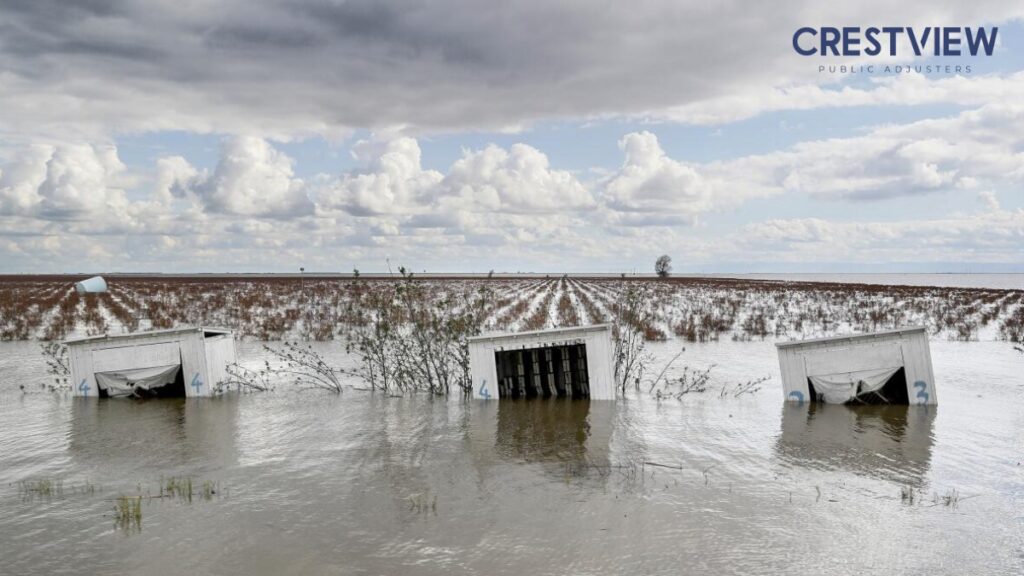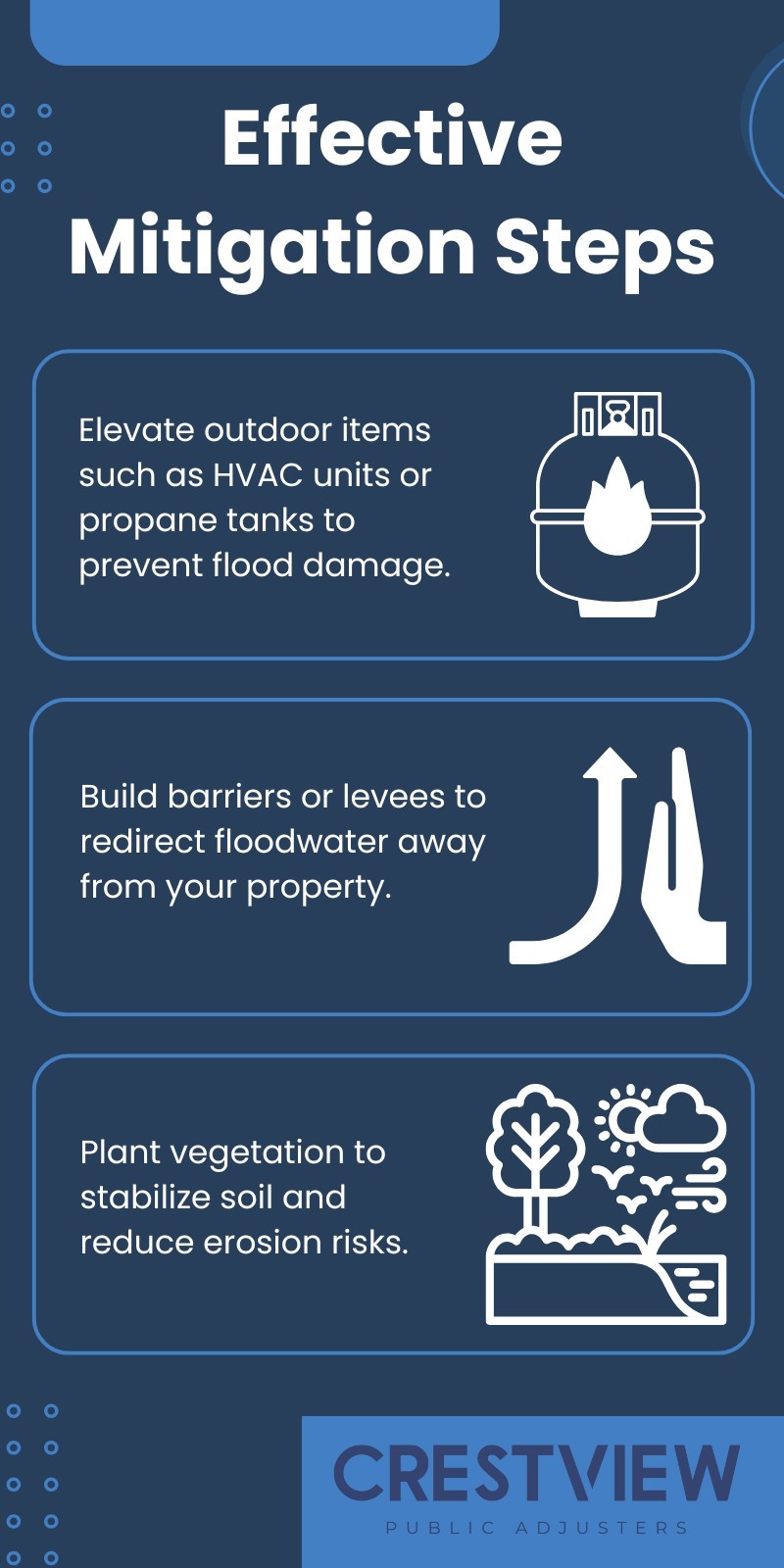Key Points:
- Snowmelt flooding occurs when warming temperatures cause snow to rapidly melt, leading to overflowing rivers, saturated soil, and overwhelmed drainage systems.
- Factors such as snowpack density, soil conditions, and weather patterns significantly influence the likelihood of flooding.
- Homeowners in at-risk areas should understand the warning signs and take preventive measures to mitigate damage from snowmelt flooding.
Snowmelt flooding happens when snow accumulations melt too quickly for natural drainage systems to handle. This results in excessive runoff that can overflow rivers, saturate soil, and flood low-lying areas. It typically occurs in regions with heavy snowfall during late winter or early spring, as temperatures rise or rain falls on snow-covered terrain.
The risk increases when rapid warming or rain accelerates the melting process. This phenomenon is especially common in mountainous regions or areas prone to seasonal thaw. For homeowners, understanding how and why snowmelt flooding occurs is crucial to protecting property and preparing for potential damage.
What Causes Snowmelt Flooding?
Several factors contribute to snowmelt flooding, and they often work in combination to increase the severity of the event.
- Rapid Temperature Increases
A sudden rise in temperature that melts snow quickly leaves the water without enough time to drain naturally. This can overwhelm riverbanks and stormwater systems, especially in urbanized areas with poor drainage infrastructure. - Rain-on-Snow Events
Rain falling on top of existing snow can significantly increase runoff. The additional water saturates the snow, causing it to melt at an accelerated pace and generate excess flow. - Saturated Soil Conditions
Once soil is already saturated from previous precipitation or melting, it can no longer absorb additional water. This forces more snowmelt runoff to flow into rivers, streams, and low-lying areas, increasing flood risks. - Terrain and Topography
Steep slopes or poorly drained lowlands are particularly vulnerable to flooding caused by rapid snowmelt. Areas near rivers, creeks, or reservoirs may experience faster water accumulation due to their geographical layout.
Why Does Snowmelt Flooding Pose Significant Risks?
Snowmelt flooding can cause widespread damage to homes, infrastructure, and the environment. Its unpredictability, coupled with rapid water accumulation, makes it one of the most challenging types of flooding to prepare for.
Impact on Homes and Properties
Basements and ground floors are especially at risk, as water intrusion can cause structural damage, mold growth, and the destruction of personal belongings. Additionally, ice jams, which occur when melting snow and ice block river flow, can create localized flooding events that cause significant damage in a short time.
Environmental Consequences
Snowmelt flooding also affects agricultural land, causing soil erosion and loss of nutrients. Flooded fields may take weeks or months to recover, delaying planting schedules and impacting crop yields.

How Can Homeowners Prepare for Snowmelt Flooding?
Understanding risk factors and taking proactive measures can help minimize damage from snowmelt flooding.
- Monitor Weather and Snowpack Conditions
Stay informed about weather forecasts, particularly during late winter and early spring. Pay attention to snowpack depth and density, as these factors indicate how much water will be released when temperatures rise. - Improve Property Drainage
Ensure gutters, downspouts, and storm drains are clear of debris. Installing sump pumps and French drains can also help direct water away from your home. - Elevate and Seal Vulnerable Areas
Elevate electrical systems, appliances, and valuables above potential flood levels. Waterproofing basements and sealing cracks in walls or foundations can reduce water intrusion. - Purchase Flood Insurance
Most standard home insurance plans exclude coverage for flood-related damage. Securing a flood insurance policy tailored to your location ensures financial security in cases of flooding caused by melting snow.
Signs of Snowmelt Flooding
Recognizing the early signs of snowmelt flooding can give you valuable time to act:
- Rising water levels in nearby rivers or streams.
- Increased pooling or standing water in low-lying areas.
- Ice jams forming in rivers or near culverts.
If you notice these signs, take immediate precautions to protect your home and loved ones.
Snowmelt Flooding: Mitigation and Recovery
Mitigating the effects of snowmelt flooding involves a combination of preparation and immediate response. After flooding occurs, recovery can be time-consuming and expensive, especially if homeowners lack adequate insurance coverage or knowledge of claim processes.

Navigating the Recovery Process
The aftermath of snowmelt flooding can be overwhelming. Cleaning and repairing flood damage often requires specialized services, and navigating insurance claims can feel daunting. Understanding your policy and knowing when to seek professional help is essential for a smooth recovery.
Protect Your Property With Expert Guidance
When snowmelt flooding impacts your home, navigating the complexities of insurance claims can be stressful. That’s where Crestview comes in.
We specialize in helping policyholders secure the compensation they deserve for winter damage claims, including snowmelt flooding, our team of public adjusters in New York, New Jersey, or Florida will work to maximize your claim and ease the recovery process.
Don’t wait—contact Crestview today to protect your home and secure your peace of mind.

